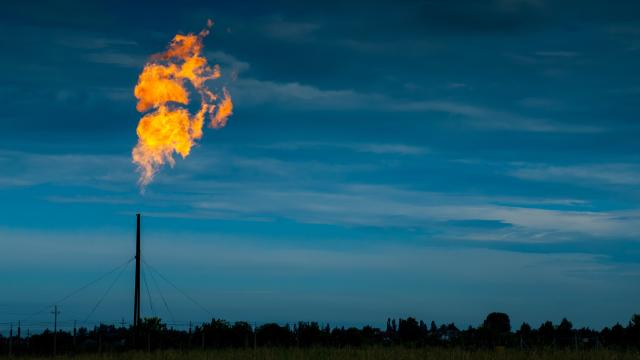Among all the other destruction war brings, there are also the environmental consequences. As conflict rages, nations intensify their focus on weapons and political strategy over climate mitigation and ecological regulation. And Russia’s ongoing war in Ukraine is no exception.
European Union sanctions and Russian retaliatory export bans seem to have left a Russian natural gas plant burning off its supply in mass quantity. Instead of exporting the fuel as liquified natural gas to Germany like usual, the plant at Portovya is simply burning it away, without extracting energy from it, according to an analysis by Rystad Energy shared with Gizmodo and originally reported on by the BBC.
The plant has been flaring through an estimated 153 million cubic feet of gas daily, which is about $AU14 million worth of the fuel, for more than a month now. In other terms: The daily carbon dioxide emissions from the huge gas flare, visible from nearby Finland and via satellite, are equivalent to the amount of CO2 produced by about 1,800 gas cars in a year.
And it’s not just the carbon emissions, but also the soot that’s worrying to climate scientists. Accumulating soot in the Arctic could exacerbate the already rapid melting of polar ice.
Why Is Russia Burning Off the Gas?
The Portovya facility was under construction when the Russia-Ukraine war began. It was being built to compress and process natural gas into its liquid form, for shipment to Germany (and onto other European countries) via the Nord Stream 1 pipeline. Yet, the pipeline has only been transporting about 20% of its total capacity since late July.
European countries and the U.S. have imposed sanctions on imports of Russian oil and gas since the invasion of Ukraine. The EU, for instance, has said it aims to be two-thirds less reliant on Russian gas in the next year. In response, Russia cut off much of Europe’s existing gas supply and slowed exports.
Rystad’s report said it’s not exactly clear why Russia is opting to flare the gas instead of reducing production. Yet, the research and analysis company posed some possible motivations. The report suggested that the extraneous burning could be the result of an uncoordinated system or part of testing procedures for the Portovya plant. However, the analysis authors noted that the size and duration of the ongoing flare seem extreme for either of those explanations.
“Could the intent be political in nature? The flaring flame is highly visible, perhaps indicating that gas is ready and waiting to flow to Europe if friendly political relations resume,” wrote the authors.
Though others have a different perspective. The German ambassador to the United Kingdom told BBC that Russia was burning the gas simply because the country is unable to sell it anywhere.
What Are the Consequences?
“I’ve never seen an LNG plant flare so much,” Jessica McCarty, an expert on satellite data and natural resource use at Miami University in Ohio, told the BBC. “Starting around June, we saw this huge peak, and it just didn’t go away. It’s stayed very anomalously high,” she added.
In fact, the flare is so large that the first indications something odd was going on first emerged via reports from Finland, saying that the country was seeing evidence of a large flare on the horizon, said the BBC.
Flaring the gas is a better option than simply venting the methane unburned, as methane is 25x as potent a greenhouse gas as CO2. However, the better environmental option would undoubtedly be to not produce the natural gas at all, especially if it’s not going to be used to generate energy. The EU has ramped up coal burning (an even dirtier fuel than natural gas) to try to offset the deficit from Russia — meaning a double dose of greenhouse gas emissions.
Russia was already the number one flaring country globally, according to World Bank data, and the recent increase indicated by the Portovya facility is certainly worrying at a moment when we need to be cutting greenhouse gas emissions worldwide.
On top of the CO2, flaring gas creates soot, or “black carbon,” which can speed up ice melt at the poles — especially when it’s coming from somewhere as far north as Russia. “Of particular concern with flaring at Arctic latitudes is the transport of emitted black carbon northward where it deposits on snow and ice and significantly accelerates melting,” Matthew Johnson, an emissions researcher at Carleton University in Canada, told the BBC.
Some estimates “already put flaring as the dominant source of black carbon deposition in the Arctic,” he added. “Any increases in flaring in this region are especially unwelcome.”
